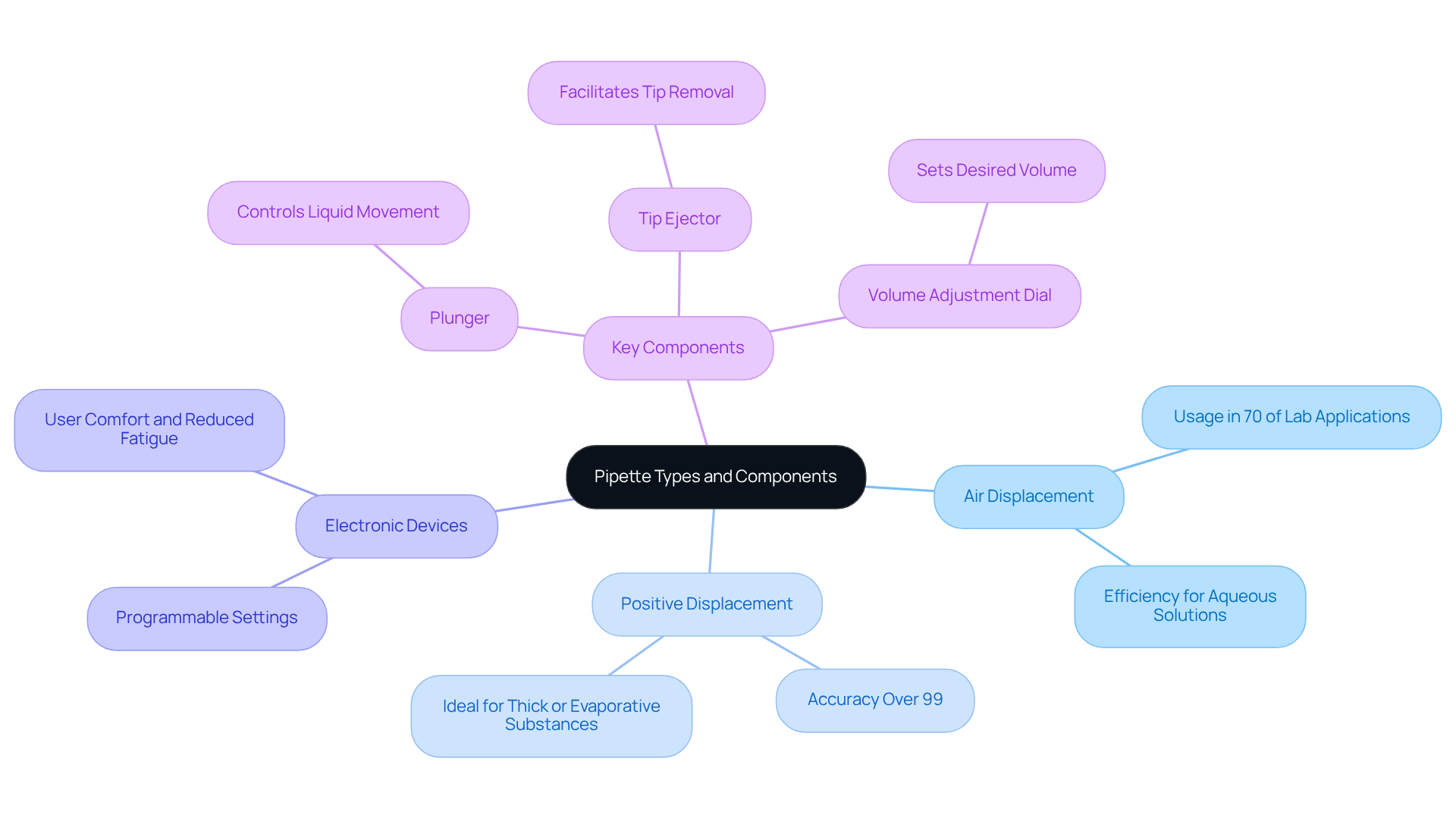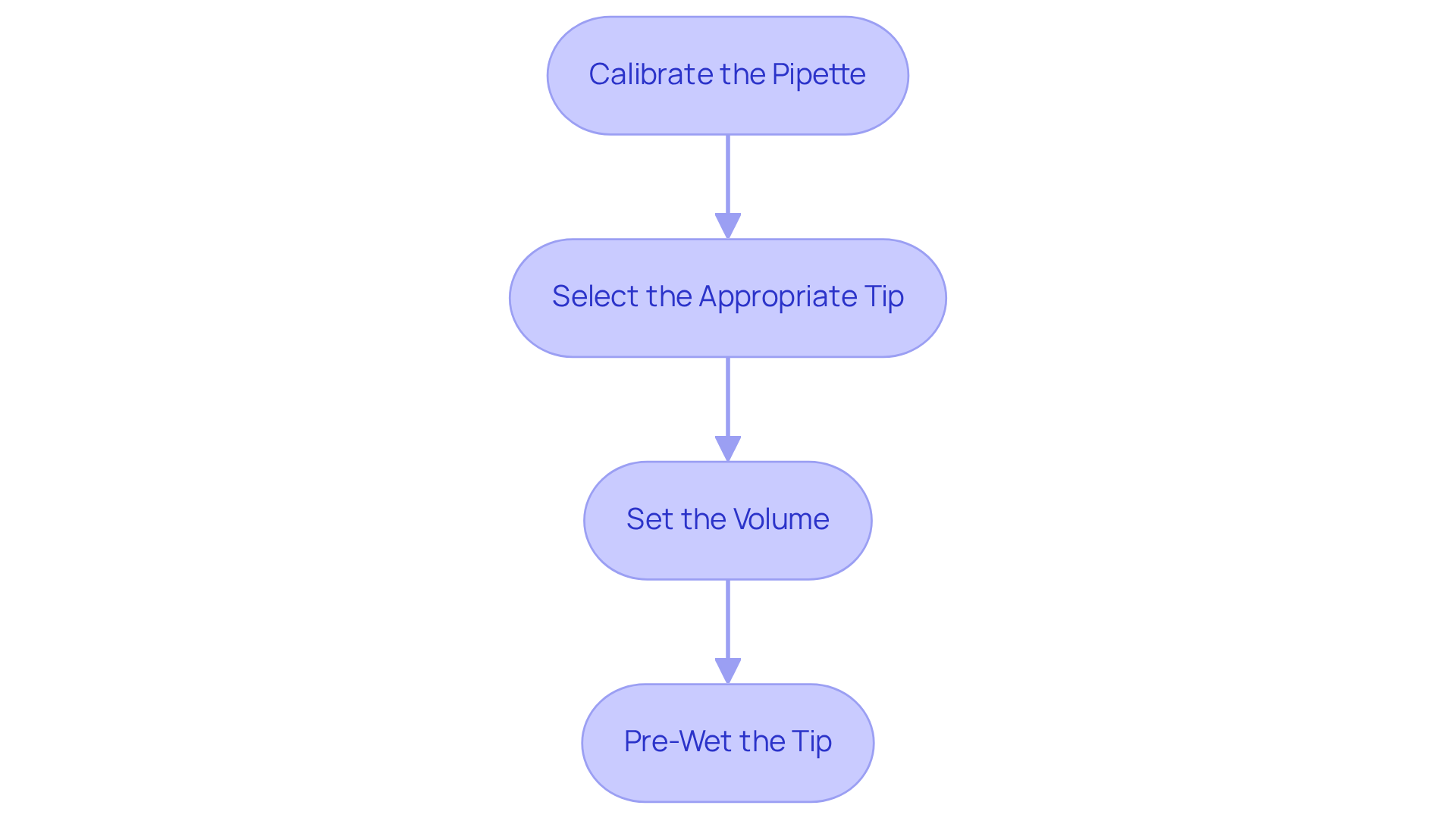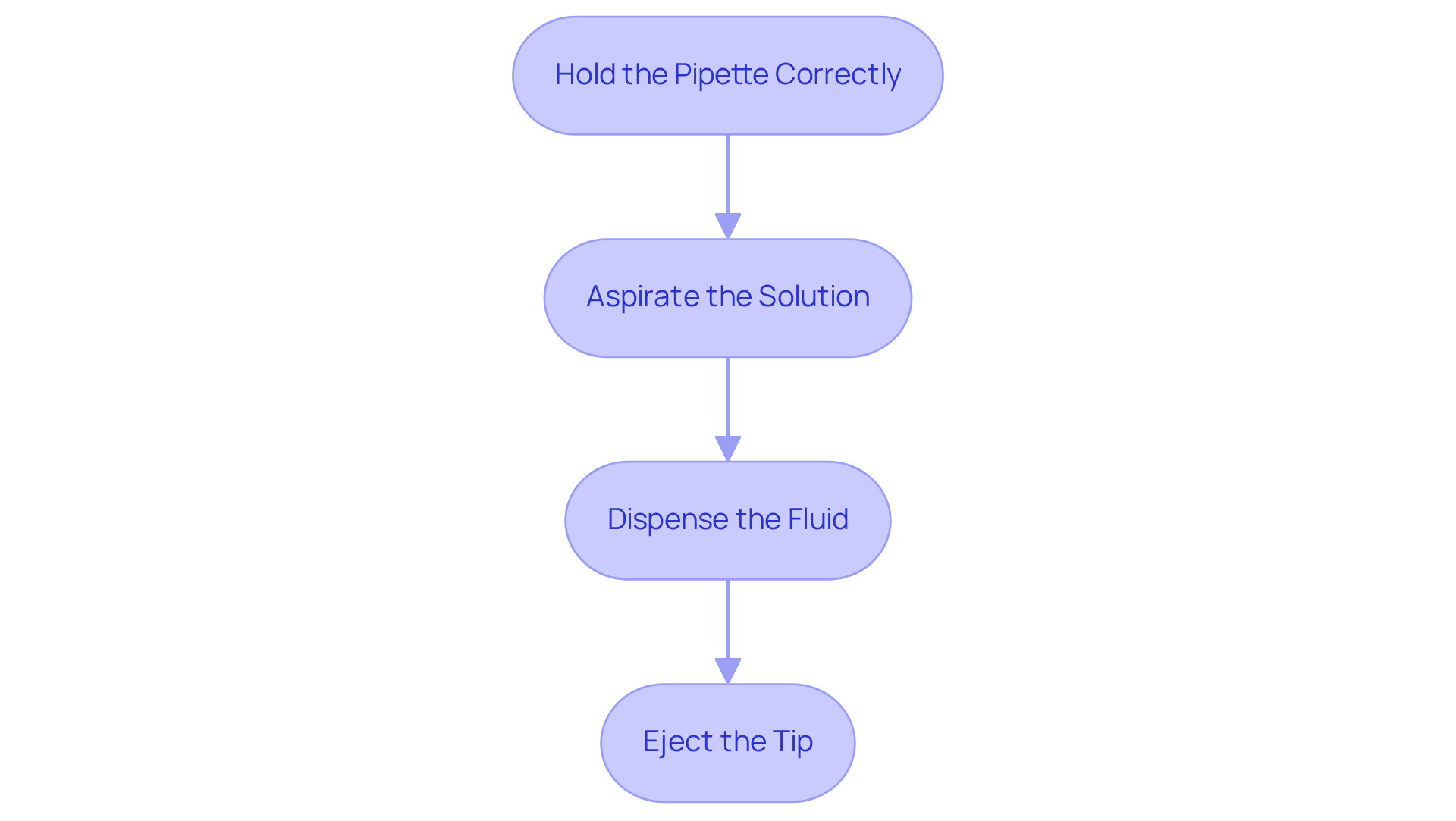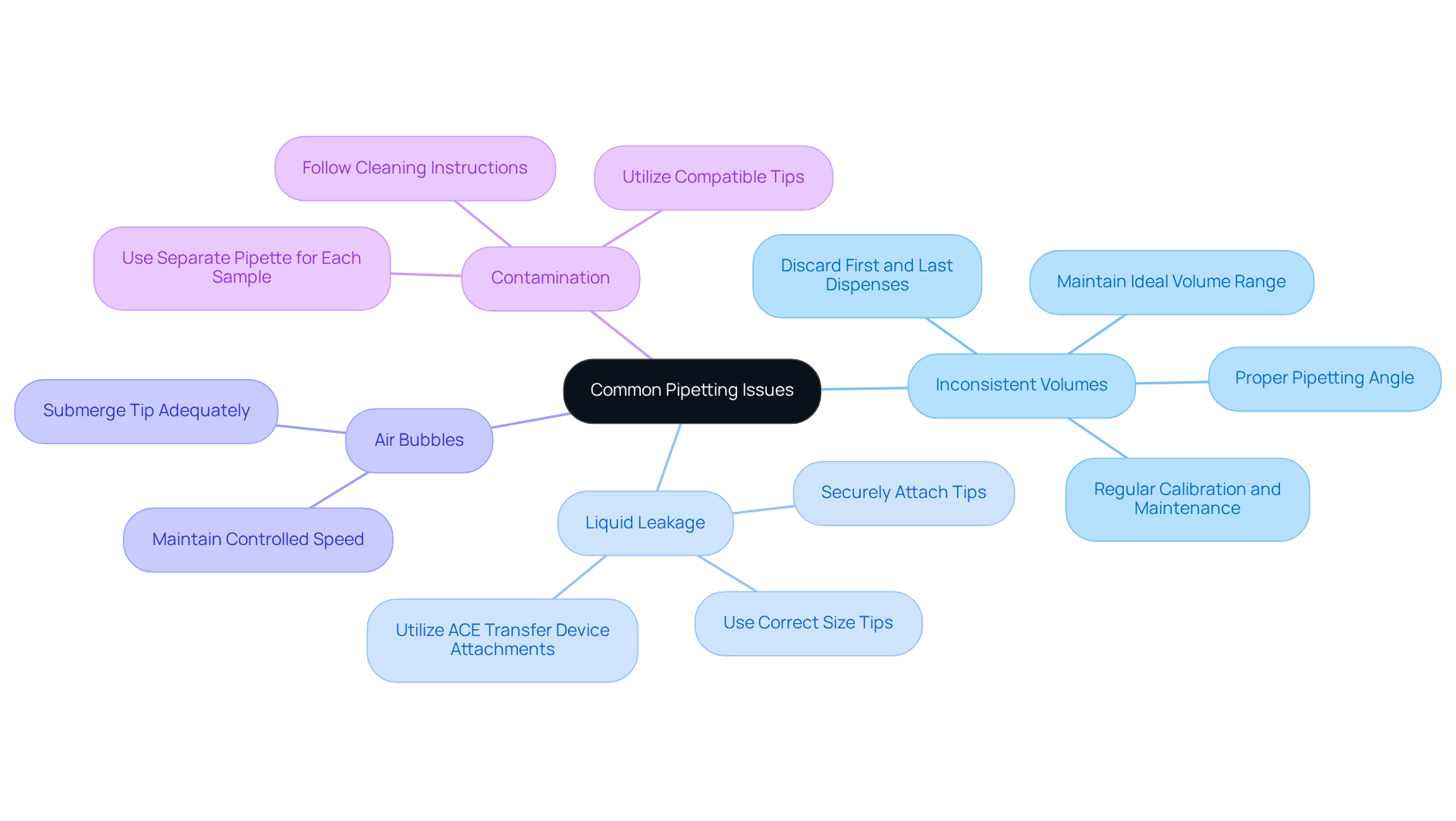Overview
This article emphasizes the mastery of utilizing a 10 ml pipette, a crucial tool for ensuring accurate measurements in laboratory environments. It begins by capturing the reader's attention with the significance of precision in scientific work. The subsequent sections delve into essential steps, including:
- Preparation
- Technique
- Troubleshooting
These steps are vital for achieving reliable results. Proper calibration and technique are highlighted as fundamental practices, while awareness of common issues, such as:
- Inconsistent volumes
- Contamination
is underscored as critical for success in laboratory settings. By following these guidelines, laboratory professionals can enhance their measurement accuracy, thereby reinforcing the integrity of their scientific endeavors.
Introduction
Mastering the art of liquid measurement is crucial in laboratory settings, where precision can determine success or failure. The 10 ml pipette, a staple in scientific research, embodies a blend of versatility and accuracy. However, many users encounter challenges in its optimal use.
What key techniques and common pitfalls can undermine measurement reliability?
How can laboratory professionals enhance their pipetting skills to ensure consistently accurate results?
Addressing these questions is essential for elevating laboratory practices.
Understand Pipette Types and Components
The pipette 10 ml is an essential tool in laboratories, available in various types, each designed for specific applications.
Air Displacement Pipettes are the most commonly used type, utilizing air pressure to draw liquid into a disposable tip. They are especially efficient for aqueous solutions and are broadly applicable in laboratory environments, representing a considerable share of usage statistics. Studies indicate that air displacement devices are utilized in about 70% of laboratory applications, emphasizing their prevalence and reliability.
Positive Displacement Devices are specifically crafted for managing thick or evaporative substances. By employing a piston mechanism to directly displace the liquid, they ensure high accuracy, making them indispensable for precise measurements in challenging applications. Laboratory experts often observe that positive displacement devices can reach accuracy levels surpassing 99% when utilized properly, particularly in crucial experiments involving thick materials.
Electronic Devices provide programmable settings, making them perfect for repetitive tasks. They enhance precision and significantly , which is crucial in high-throughput environments. Recent advancements, such as the [Eppendorf Research 3 neo instrument](https://jmscience.com/products/copy-of-nylon-economy-syringe-filter-13mm-0-45um-1?srsltid=AfmBOooWyLZNTIw7SFl_7DiobUEdbizuTFZ0RFQC4RHrW9oozsjFtpGW), have introduced features that improve adaptability and comfort, further enhancing their utility in contemporary laboratories.
Comprehending the elements of a pipette 10 ml is essential for efficient operation. Key parts include:
- Plunger: Controls the movement of liquid into and out of the pipette, allowing for precise volume control.
- Tip Ejector: Facilitates the removal of disposable tips, ensuring a clean and efficient workflow.
- Volume Adjustment Dial: Allows users to set the desired volume accurately, which is essential for maintaining consistency in experiments.
Laboratory professionals emphasize the importance of familiarizing oneself with these components to troubleshoot effectively and optimize pipetting techniques. For example, in the case of thick fluids, positive displacement instruments have demonstrated superiority over air displacement models, ensuring dependable outcomes in crucial experiments. By mastering the functionalities of various types of liquid transfer devices and their components, laboratory managers can enhance accuracy and efficiency in their workflows.

Prepare the Pipette for Accurate Measurements
To prepare your pipette effectively, follow these essential steps:
- Calibrate the Pipette: Regular calibration is crucial for ensuring accuracy. Adhere to the manufacturer's guidelines for calibration procedures, which typically involve using a balance to weigh the dispensed liquid. This practice not only enhances precision but also establishes the reliability of your measurements.
- Select the Appropriate Tip: Choosing a tip that corresponds to the volume range of your device is vital. Ensure that the tip is securely attached to prevent leaks, as any compromise in the seal can lead to significant errors in your results.
- Set the Volume: Adjust the volume setting on the pipette to the desired measurement. It is important to turn the dial slowly to avoid overshooting the desired volume, thus maintaining the integrity of your liquid handling.
- Pre-Wet the Tip: To condition the tip, aspirate and dispense the solution a few times. This practice minimizes errors caused by liquid adhesion to the tip walls, ensuring that your measurements are both accurate and consistent. By following these steps, you reinforce the importance of using high-quality scientific instruments in laboratory settings.

Master the Technique of Pipetting
To master pipetting effectively, it is essential to follow these critical steps:
- Hold the Pipette Correctly: Grip the pipette firmly with your thumb on the plunger and your index finger on the volume adjustment dial. Use your other hand to stabilize the container holding the substance, ensuring a steady grip.
- Aspirate the Solution: Press the plunger to the first stop, insert the tip into the solution, and slowly release the plunger to draw the solution into the tip. Avoid touching the sides of the container to prevent contamination and ensure accurate measurements. Pre-wetting the pipette tip by aspirating and dispensing the substance a couple of times before measuring can enhance accuracy and minimize errors.
- Dispense the Fluid: Position the tip over the receiving container, press the plunger to the first stop to dispense the fluid, and then press to the second stop to expel any remaining fluid in the tip. This technique minimizes residual liquid, .
- Eject the Tip: Use the tip ejector to dispose of the used tip without touching it, maintaining a clean workspace and reducing the risk of cross-contamination.
Frequent errors in liquid handling can significantly affect outcomes. For instance, improper tip selection or neglecting to pre-wet tips can lead to inaccuracies. Experienced lab technicians emphasize that skipping the pre-wetting step with a pipette 10 ml is akin to starting a race with untied shoelaces—risking errors in measurement. Additionally, a study revealed that 44% of lab technicians indicated hand issues, and 58% noted shoulder problems caused by their work, highlighting the significance of correct technique and ergonomics. Regular calibration and maintenance of pipettes are crucial for ensuring reliability and precision in laboratory settings. By adhering to these best practices, laboratory professionals can enhance their liquid handling skills, ultimately leading to more reliable and reproducible results.

Troubleshoot Common Pipetting Issues
Frequent liquid handling problems can significantly affect laboratory results, leading to inaccuracies that undermine experimental integrity. Addressing these issues is crucial for maintaining high standards in scientific research. Below are some prevalent problems along with their effective solutions:
- Inconsistent Volumes: Variability in pipetting volumes often arises from improper technique or a malfunctioning pipette. To mitigate this issue, ensure that when you pipette 10 ml, you operate within the ideal volume range of 35-100% of the device's nominal capacity. Additionally, maintain a pipetting angle that does not exceed 20 degrees to minimize inconsistencies. Regular calibration and maintenance of the pipette 10 ml are essential to ensure reliable performance. Furthermore, when performing repeat dispensing, it is advisable to discard the first and last dispenses to eliminate variability.
- Liquid Leakage: Leakage from the device tip can occur if the tip is not securely attached or if an incorrect size is used. Always verify that the dispensing points are appropriate and properly attached before you pipette 10 ml to prevent leakage, which can result in erroneous measurements. Utilizing ACE transfer device attachments, designed to during liquid handling tasks, can enhance overall precision.
- Air Bubbles: The presence of air bubbles can skew results. To avoid this complication, ensure that the tip of the pipette 10 ml is adequately submerged during aspiration and maintain a steady, controlled speed to prevent rapid movements that may introduce air into the liquid.
- Contamination: Cross-contamination can compromise sample integrity. Always utilize a pipette 10 ml for each sample to prevent this issue. It is crucial to use compatible tips from the same manufacturer as the instrument to avoid problems such as dripping or misalignment. In the event of contamination, adhere to the manufacturer's cleaning instructions to restore the pipette's functionality.
Addressing these frequent liquid handling issues is essential for upholding precision and dependability in laboratory measurements. By implementing best practices and engaging in regular training, you can significantly enhance pipetting techniques, ensuring consistent and accurate results.

Conclusion
Mastering the use of a 10 ml pipette is essential for achieving accuracy and reliability in laboratory measurements. Understanding the various types of pipettes, their components, and the proper techniques for usage empowers laboratory professionals to perform their tasks with confidence and precision. This article underscores the significance of selecting the appropriate pipette type, preparing it adequately, and employing correct pipetting techniques to minimize errors and enhance measurement consistency.
Key points discussed include:
- The importance of regular calibration
- The selection of suitable tips
- The necessity of pre-wetting to prevent inaccuracies
Additionally, common issues such as inconsistent volumes, liquid leakage, air bubbles, and contamination are addressed with effective troubleshooting strategies. By adhering to best practices and maintaining a focus on technique, laboratory professionals can significantly improve their liquid handling skills, ultimately leading to more reliable experimental outcomes.
In the realm of scientific research, the accuracy of measurements can have profound implications. Therefore, it is imperative for lab technicians to invest time in mastering pipetting techniques and understanding their tools. By doing so, they not only enhance their own efficiency but also contribute to the integrity of scientific results. Embracing these practices fosters a culture of precision that is essential for advancing research and ensuring reproducibility in laboratory settings.




